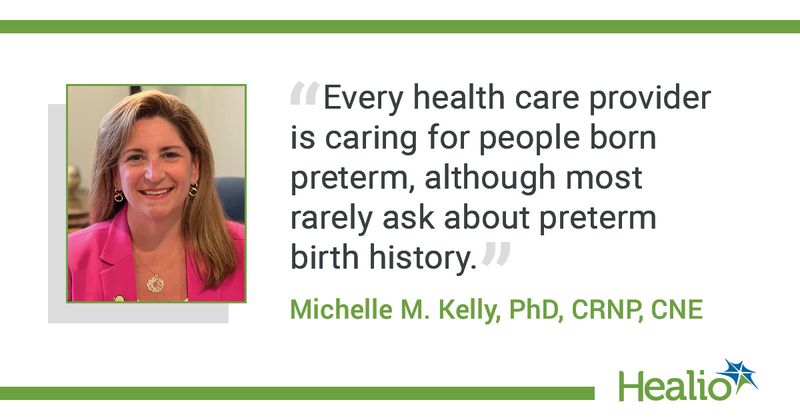Q&A: What does an increase in preterm births mean?
Key takeaways:
- Preterm and early-term birth rates have risen since 2014.
- Preterm birth increases likelihood of both physical and psychiatric conditions.
Preterm and early-term birth rates in the United States rose from 2014 to 2022 while rates of late- and post-term births declined, according to a report published this week by the CDC.
Specifically, data showed that preterm and early-term birth rates rose by 12% and 20%, respectively, and full- and late-term or post-term births declined by 6% and 28%.

We spoke with Michelle M. Kelly, PhD, CRNP, CNE, an associate professor in the Villanova University M. Louise Fitzpatrick College of Nursing at and frequent researcher of issues related to preterm birth, about the new report.
Healio: What was your reaction to the report?
Kelly: I am not surprised by this year’s update on preterm birth rates in the U.S. but I hope that [it reaches] those who have influence over health care and education-related public policy. Most preterm births occur between 34 to 36 weeks of gestation, the group that also saw the greatest percent increase over time. These “close enough” infants may spend short to no periods of time in the NICU and are generally discharged home without any significant health concerns. However, as infants, they are more likely to be readmitted to the hospital in the first year of life. Additionally, the report highlights the increased incidence of preterm birth that affects families of color.
People born preterm comprise a significant portion of the population, and in countries like the U.S., 95% of people born preterm survive to adulthood. That means that every health care provider is caring for people born preterm, although most rarely ask about preterm birth history. Failing to ask about, document and consider preterm birth as a component of past medical history means we are missing an opportunity to mitigate the risk associated with being born early. Those risks are modifiable, just as the risk posed by a family history of heart disease is modifiable.
Healio: What elements of care are overlooked for preterm infants?
Kelly: Research supports that although infants born at 32 or 34 weeks of gestation are doing “fine,” they may experience low-severity, high-frequency developmental concerns and health issues that are not being addressed. In most states, infants born after 32 weeks of gestation are not automatically eligible for early intervention and yet research shows that they are indeed vulnerable. As toddlers and school-aged children, they are more likely than their term peers to require special education services, experience wheezing and asthma, experience behavioral and emotional- and attention-related conditions.
Healio: How can preterm birth affect a child into adulthood?
Kelly: Preterm birth contributes to the risk of developing cardiovascular conditions like hypertension, respiratory conditions associated with decreased lung function and chronic kidney disease. Preterm birth also increases the risk of psychiatric conditions like depression and anxiety. Studies suggest that although there is a gradient, the risk is not limited to those who were born at the youngest gestational ages or who experienced significant illness as infants. In 2017, the NIH determined that even a modest increase in risk for future chronic illness associated with preterm birth represents a significant burden to the individual and to the health care system.
Healio: What should pediatricians look for in early visits to combat these issues?
Kelly: Pediatric and family health care providers need to use preterm birth as a component of risk assessment. This is the basis of the recommendations my colleagues and I put forth for addressing preterm birth history across the lifespan. Children born preterm experience the same common chronic conditions experienced by their term peers, especially those that affect development and academic success — asthma, learning disability, ADHD, anxiety and speech problems. However, preterm children experience them with significantly increased frequency.
It is crucial that preterm birth is considered and early referral for support services to combat educational and behavioral concerns occurs. This includes communicating the potential risk to the family and to the child’s educational team. It is also important to consider the implications of poverty and toxic stress experienced by families because research supports that poverty and toxic stress both increase the risk of preterm birth and negatively impact health and educational outcomes. Further, pediatric and family health care providers need to promote healthy lifestyles to reduce risk associated with adolescent and adult onset of respiratory, cardiovascular and kidney-related conditions.
References:
Martin JA, et al. Natl Vital Stat Rep. 2024;73(1):1-11.
